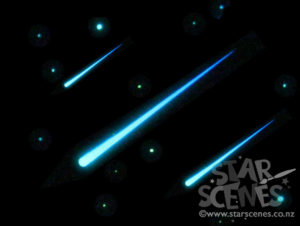how to see more shooting stars
If you’re planning to stay up late or wake up early to see one of these celestial fireworks displays, you want to make sure you get the most bang for your buck.
Read on and find out everything you need to know about how to watch a Meteor Shower.
do a little research first
The main things you need to know beforehand are:
-
What date is the Meteor Shower date/time expected to peak?
Meteor Showers normally span a few weeks at a time, but astronomers are able to pinpoint the best 1-2 nights for viewing. These are the nights you can expect will have the most meteors per hour.
The best viewing time is normally between midnight and dawn. But it also depends on where you are in the world and when the constellation will be visible in the sky.
-
What will the weather be like?
The amount of cloud cover can seriously impede your efforts to see shooting stars, which is why it’s important to check the weather forecast ahead of time.
The easiest place to find out whether it’s expected to be a good night for stargazing is accuweather.com. Simply choose the Astronomy option under the personalized forecast tab.
-
What phase will the moon be in?
Just like with our realistic glow in the dark stars, ambient light can make it more difficult to see celestial objects in the night sky.
For this reason, the best time to view meteors is during a new moon (where the moon isn’t illuminated) or before the moon rises. A waxing or waning crescent moon should also be fine.
But if it’s a full moon, a gibbous moon, or a 1st or 3rd quarter moon, you may find it difficult to see as many shooting stars in the the sky. And when there’s a supermoon? I wouldn’t even bother!
A handy place to search for when the moon will rise and set in your city or country is timeanddate.com This handy webpage will even tell you what percentage of the moon is illuminated at the moment.
-
What constellation will the meteors radiate from?
This can be a helpful way of knowing where to look.
You can use a Star Map app to find the constellation in the sky. Or simply find out which direction (e.g. northwest) you should be facing and look between the horizon and the zenith (the highest point in the sky).
what to bring on the night
- A reclining chair or waterproof beanbag to lie on. You’re going to want to be comfortable!
- A blanket or sleeping bag. It can get pretty cold at night when you’re not moving around, especially in the cooler months.
- Mosquito repellent. Because. Mozzies. Suck.
- Snacks, a thermos of warm drink, and friends or family to watch it with. Stargazing and meteor watching can set the perfect atmosphere for reconnecting with loved ones.
- And by the way, you won’t need binoculars or a telescope. The naked eye is best because you’ll be able to see more of the sky and notice more meteors.
more tips for the big night
- Find a nice dark place to sit, as far away from city lights, buildings and trees. A wide open space like a park can be a perfect viewing spot, if you don’t live out in the country.
- Give your eyes 15-30 minutes to adjust to the dark. And don’t spoil your night vision by bringing a torch or your phone.
- And don’t forget to count how many meteors you see. Might as well wish on those shooting stars too!
make it easy for yourself
Sign up for free Meteor Shower Alerts from us here at StarScenes.
We summarize all the important details for you, so you can sit back and relax knowing you’ll never miss out on another Meteor Shower again. Sign up here:

